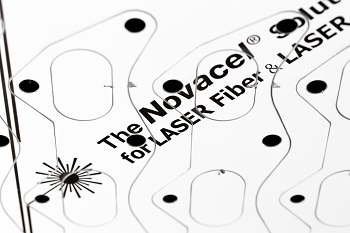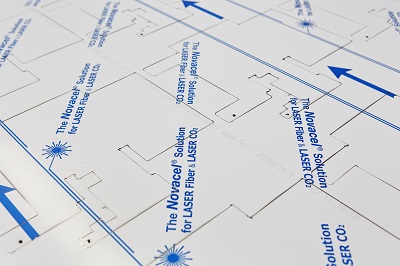Exterior sheet metal parts that aren’t treated or painted require a protective film. This mainly includes parts made out of stainless steel, aluminium and copper, with various finishes: brushed, glossy, etc.
The challenge is to limit the impact of this protective film on overall productivity. Laser cutting of the sheet metal and film should be done at full speed, in one cut.
If you have to cut twice or reduce the machine’s speed, then you’ve got a problem that needs to be solved. The film should also not ‘bubble’ during the cutting phase, and the operation to remove it should be easy, without leaving any residue.
This article, compiled with the help of two major players in film manufacturing, Novacel and Polifilm, will discuss:- The difficulties linked to laser cutting sheets with protective film, i.e., bubbling.
- The importance of the film removal phase.
- How to choose the right film and what markers should be used for quality control by an operator?
- Clues to detect an anomaly and areas to be investigated.
1- Sheet Metal Protective Film Bubbling During Laser Cutting
Bubbles may form under the film if cutting gas escapes between the sheet and the film during cutting. The risks are as follows:
- a large bubble catching on the laser head and dragging the sheet away, resulting in uncontrolled movements and consequently significant damage.
- damage to the head and lens.
In 90% of cases, bubbling occurs during the drilling phase.
The risk of bubbling is amplified when the cuts are very close together. For example, small holes that are very close together. The gas pressure is concentrated on a very small surface and bubbles appear. There is also a strong risk of bubbling when the holes are less than 5mm apart. In this case, vaporisation must be carried out to avoid bubbling, i.e., burning the film before the cutting and, more specifically, the drilling phase. ‘Pre-drilling’ is available on most machines and can be done in the same operation as drilling, without significantly impacting productivity.
When the distance between the holes is greater, the holes are made in an area where the film is intact. There is therefore less risk of bubbles.
2- Removing the Protective Film From Sheet Metal
Removing the protective film can also lead to difficulties, resulting in:
- significant time loss to carry out this operation, and therefore a loss of productivity,
- mechanical distortion of the products and/or adhesive residue when the operator removes the film.
Pre-cutting the film during laser cutting simplifies this operation and limits the stress on the material, without damaging the sheet metal as would be the case with a cutter.
3- Film Selection and Quality Control
Protective film on sheet metal impacts the production process. Yet, suppliers standardise films, at the cost of optimising the cutting process. However, when the volumes are high enough, or if the film is applied in-house, then the manufacturer can choose a more suitable film.
When choosing the film, it’s important to find a balance between high adhesion to limit bubbles and low adhesion to make the film easier to remove.
A) With this in mind, there are several aspects to consider when choosing a film :
? the cutting technology: fibre laser source or CO2 laser
A fibre laser’s wavelength is ten times shorter than that of a CO2 laser and is not absorbed by the plastic. Thus, using a film designed for CO2 laser would create a very uneven cut if used with a fibre laser source. In fact, films specifically for fibre laser cutting have built-in absorbers.
? the material: stainless steel, aluminium, pre-lacquered, etc.
Copyright Novacel Stainless steel/aluminium: Some materials are highly thermally conductive, e.g., aluminium, copper, etc. In this case, the heat spreads when cutting and can melt the film. The sheet protection for these materials therefore must be adapted, with a higher level of thermal resistance than a film for stainless steel, for example.
Pre-lacquered steel: Cutting pre-lacquered steel can be problematic if the lacquer used is not designed for good laser wave absorption. Even if there are specific films, the lacquer must be adapted, in particular with specific additives.
Double-sided: Double-sided protection can cause a small amount of burring during cutting, because the film on the table side retains the material. It is therefore recommended to use thin films, which reduce, or even eliminate, quality problems.
? Thickness of the sheet metal used
Depending on the thickness, the pressure of the cutting gas is different and therefore does not require the same level of adhesion. As a result, a film designed for thin sheet metal will result in a lot of bubbling if used on thick sheet metal.
? Material finishes: brushed, glossy, scotch-brite, etc.
Adhesion depends on the surface and the film products are adapted to each surface. It is therefore important to take the finish of the material into account when choosing a film.
B) Quality control: how to ensure that the film is suitable and properly applied?
Copyright Novacel
? Specific colour codes and markings enable the operator to identify the type of film for visual inspection. Brice Lequette – Novacel explains: "The protective film for a CO2 laser is black on the glue side and white on the outside, whereas for a fibre laser it is black on the glue side and grey on the outside.”
? It is important to properly apply the film, especially by limiting its elongation. This is because plastic is a shape memory material that will return to its original size if elongated. Elongation reduces adhesion and the film will therefore be less resistant to gas pressure, leading to an increased risk of bubbling.
A quick test can be carried out to check that the film has been properly applied:- peel off a strip of film from the sheet,
- wait a minute,
- compare the length of the removed film to the area where it was stuck. The difference should not be more than 1%.
A few visual clues can also alert to any issues, such as small application defects like bubbles, etc.
? The sheet metal should not be cut for 48 hours after applying the film.
4- What Clues and Points of Analysis Can be Used to Detect a Problem With Film Cutting? How Can They Be Resolved?
A few visual clues can reveal a problem with the film or be used to detect machine parameters that have an impact on quality:
- bubbling of the film,
- black edges during cutting or burr,
- shrinkage caused by cutting that must be reduced to ensure that the sheet/part remains protected as much as possible,
- residue when the film is removed.
Carrying out a little ‘investigation’ by changing the machine settings can help identify the causes or at least rule out any problems with the machine, film lamination, sheet or film quality. These modifications, carried out step by step and supervised by the operator, help optimise the settings to avoid bubbling:- Drilling time (close to 0 seconds),
- Nozzle diameter (increase diameter),
- Gas pressure (decrease gas pressure - minimum 5 bars),
- Drilling mode (CW instead of Pulse mode),
- Decrease power during drilling.
If the defects persist once the machine parameters have been ruled out, the problem probably lies in the lamination of the material, choice of film or its proper use. At this stage, film manufacturers can provide support in identifying difficulties and finding appropriate technical solutions.
Copyright – reproduction prohibited without Metal-Interface’s permission
Metal-Interface takes great care to protect your privacy: when you submit a request or ask a question, your personal information is passed on to the supplier concerned or, if necessary, to one of its regional managers or distributors, who will be able to provide you with a direct response. Consult our Privacy Policy to find out more about how and why we process your data, and your rights in relation to this information. By continuing to browse our site, you accept our terms and conditions of use.
- Technical Report on Laser Cutting Technical article
Laser Cutting Sheet Metal With Protective Film: 4 Key Points!
